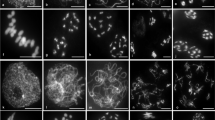Abstract
Chromosome pairing behaviour of the allotetraploid Aegilops species sharing the D genome, Ae. crassa (DDMM), Ae. cylindrica (DDCC) and Ae. ventricosa (DDNN), was analyzed by electron microscopy in surfacespread prophase-I nuclei. Synaptonemal-complex analysis at zygotene and pachytene revealed that synapsis in the allotetraploids was mostly between homologous chromosomes, although a few multivalents were also formed. Only homologous bivalents were observed at metaphase-I. It is concluded that the mechanism controlling bivalent formation in these species acts mainly at zygotene by restricting pairing to homologous chromosomes, but also acts at pachytene by preventing chiasma formation in homoeologous associations. These observations are discussed in relation to mechanisms of diploidization of polyploid meiosis.
Similar content being viewed by others
References
AbuBakar H, Kimber G (1982) Chromosome pairing regulators in the former genus Aegilops. Z Pflanzenzücht 89:130–138
Cuñado N (1992) Analysis of metaphase-I chromosome associations in species of the genus Aegilops. Theor Appl Genet 85:283–292
Cuñado N, Callejas S, García MJ, Fernández A, Santos JL (1996a) Chromosome pairing in the allotetraploid Aegilops biuncialis and a triploid intergeneric hybrid. Genome 39:664–670
Cuñado N, Callejas S, García MJ, Fernández A, Santos JL (1996b) The pattern of zygotene and pachytene pairing in allotetraploid Aegilops species sharing the U genome. Theor Appl Genet (in press)
Davies A, Jenkins G, Rees H (1990) Diploidisation of Lotus corniculatus L. (Fabaceae) by elimination of multivalents. Chromosoma 99:289–295
Driscoll CJ (1972) Genetic suppression of homoeologous chromosome pairing in hexaploid wheat. Can J Genet Cytol 14:39–42
Gillies CB (1985) An electron microscopic study of synaptonemal complex formation at zygotene in rye. Chromosoma 92:165–175
Gillies CB (1987) The effect of Ph gene alleles on synaptonemal complex formation in Triticum aestivum x T. kotschyi hybrids. Theor Appl Genet 74:430–438
Hasenkampf CA (1984) Synaptonemal complex formation in pollen mother cells of Tradescantia. Chromosoma 90:275–284
Hobolth P (1981) Chromosome pairing in allohexaploid wheat var. Chinese Spring. Transformation of multivalents into bivalents, a mechanism for exclusive bivalent formation. Carlsberg Res Commun 46:129–173
Holm PB (1977) Three-dimensional reconstruction of chromosome pairing during the zygotene stage of meiosis in Lilium longiflorum (Thunb.). Carlsberg Res Commun 42:103–151
Holm PB (1986) Chromosome pairing and chiasma formation in allohexaploid wheat, Triticum aestivum, analysed by the spreading of meiotic nuclei. Carlsberg Res Commun 51:239–294
Holm PB, Wang X (1988) The effect of chromosome 5B on synapsis and chiasma formation in wheat, Triticum aestivum, cv Chinese Spring. Carlsberg Res Commun 53:191–208
Jenkins G (1983) Chromosome pairing in Triticum aestivum cv Chinese Spring. Carlsberg Res Commun 48:255–283
Jenkins G (1985) Synaptonemal complex formation in hybrids of Lolium temulentum x Lolium perenne (L.). II. Triploid. Chromosoma 92:387–390
Jenkins G (1986) Synaptonemal complex formation in hybrids of Lolium temulentum x Lolium perenne (L.). II. Tetraploid. Chromosoma 93:413–419
Jones M, Rees H, Jenkins G (1989) Synaptonemal complex formation in Avena polyploids. Heredity 63:209–219
Kimber G, Zhao YH (1983) The D genome in Triticeae. Can J Genet Cytol 25:581–589
Martínez M, Naranjo T, Cuadrado MC, Romero C (1996) Synaptic behaviour of tetraploid wheat Triticum timopheevii. Theor Appl Genet, (in press)
McGuire PE, Dvorák J (1982) Genetic regulation of heterogenetic chromosome pairing in polyploid species of the genus Triticum sensu lato. Can J Genet Cytol 24:57–82
Mello-Sampayo T (1971) Genetic regulation of meiotic chromosome pairing by chromosome 3D of Triticum aestivum. Nature, New Biol 230:22–23
Menzel MY (1964) Preferential chromosome pairing in allotetraploid Lycopersicum esculentum x Solarium lycopersicoides. Genetics 50:855–862
Rayburn AL, Gill BS (1987) Molecular analysis of the D-genome of the Triticeae. Theor Appl Genet 73:385–388
Thomas HM (1990) Analysis of synaptonemal complexes in the amphidiploid of Lolium multiflorum x Festuca drymeja. Genome 33:903–907
Thomas HW, Thomas BJ (1993) Synaptonemal complex formation in two allohexaploid Festuca species and a pentaploid hybrid. Heredity 71:305–311
Author information
Authors and Affiliations
Additional information
Communicated by F. Mechelke
Rights and permissions
About this article
Cite this article
Cuñado, N., García, M.J., Callejas, S. et al. The pattern of zygotene and pachytene pairing in allotetraploid Aegilops species sharing the D genome. Theoret. Appl. Genetics 93, 1175–1179 (1996). https://doi.org/10.1007/BF00230143
Received:
Accepted:
Issue Date:
DOI: https://doi.org/10.1007/BF00230143



